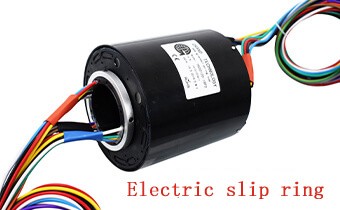Slip rings play a quintessential role in transferring electrical power and signals across rotating interfaces. This article aims to delve into the intricacies of power and signal slip rings, examining their construction, key features, common applications, and future trends.
Introduction to Power and Signal Slip Rings
Power and Signal Slip Rings are innovative devices that provide seamless, continuous electrical connections between stationary and rotating parts of various machinery and equipment. Serving as the bridge between non-moving and moving sections of machinery, these slip rings facilitate electrical communication – transmitting both power and signal – while allowing unrestricted 360-degree rotation.
A Power Slip Ring, as the name implies, primarily transfers electrical power from a stationary component to a rotary component. This is particularly crucial in systems that necessitate rotation but still require power for proper functioning. On the other hand, a Signal Slip Ring serves the purpose of transmitting electrical signals between static and rotational parts of a machine, allowing conveyed signals to control operations, channel data, or carry out diverse tasks.
The purpose of these slip rings extends across a multitude of applications due to their remarkable functionality. Power and signal slip rings are fundamental to the operation of various equipment and machinery in numerous industries including renewable energy (wind turbines), medical technology (MRI machines), telecommunications (satellite dishes), and industrial processes (rotating tanks or mixers).
These distinct yet complementary types of slip rings support and elevate the performance and efficiency of many complex electrical systems. Through the transmission of power and signals with minimal resistance or loss, they enable stationary and rotating system components to communicate effectively, thereby granting us the possibility to design sophisticated, efficient rotating systems.
In their basic role, power and signal slip rings embody the epitome of simplicity: they transfer power or send signals. However, as we delve deeper into their intricate design and operational principles, we realize their truly multifaceted nature and critical role in a world that’s constantly on the move.
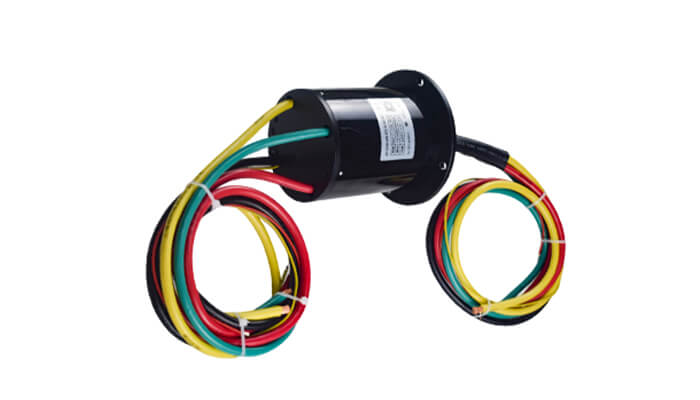
Power and Signal Slip Ring Construction and Working Principles
Power and signal slip rings, while seemingly simplistic devices bear an ingenious design and construction that facilitate their ultimate functionality. At their very core, slip rings consist of two fundamental components: a set of electrically conductive rings and ‘brushes.’
The rings, constructed from a conductive material such as copper or precious metals, are connected to the rotor part of the assembly; in other words, the part that needs to induct rotation. Depending on the requirements of the system, a single slip ring module may contain multiple individual rings, each capable of carrying an independent electrical circuit.
Accompanying these rings are the brushes, typically made of graphite or precious metal wire. The brushes maintain physical contact with the rings, and their primary role is to conduct the electric current or signal from the stationary part (usually the source of power or the signal) to the rotating rings, and consequently to the rotor component of the equipment.
The marvel of the slip ring lies not just in its construction, but more so in its operation. During the rotation process, the brush and the ring are in constant contact, forming a closed-circuit pathway. Thus, while the entire structure allows free rotation, the transmission of electric power or signal is continuous and uninterrupted. The flow of power or signals is from the stationary brushes, through the conductive rings, and onto the rotating equipment part.
The working principles of power and signal slip rings enable several critical functionalities. A Power Slip Ring ensures that even in continuous motion, electrical power is steadily and efficiently transferred from the stationary power source to the necessary rotary components. Similarly, the Signal Slip Ring guarantees that even as equipment components rotate, there is smooth, efficient communication in the form of signal transmission between the stationary control systems and the rotating parts.
In essence, the smart construction and working principles of power and signal slip rings eliminate the limitations posed by a rotating interface and open up a world of possibilities for the design and operation of a wide array of systems across various industries.
Types of Power and Signal Slip Rings
The realm of slip rings encompasses a wide variety of types, each designed to cater to specific requirements and applications. This diversity is due to the various factors, such as conductivity, torque, system voltage, and more, which must be considered in their design. Hence, slip rings can be classified based on design, materials used, and function, with power and signal slip rings being the primary sub-categories in terms of functionality.
An overview of the various types of slip rings will help us understand their unique features and advantages while focusing on the distinct characteristics of power and signal slip rings.
Compact and lightweight, these slip rings are used in devices where minimal space is available, such as CCTV cameras or robotics. Capsule slip rings can be found as both power and signal slip rings, depending on their intended application.
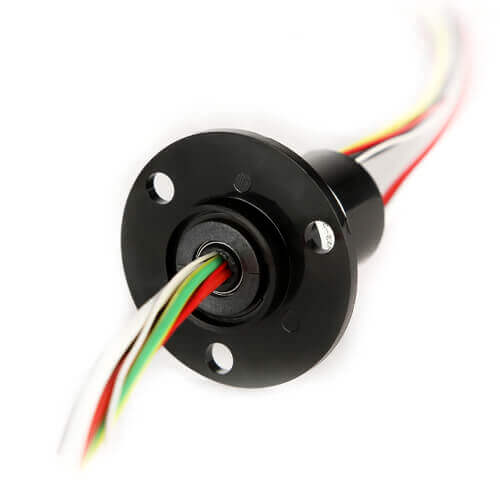
Designed with a hollow shaft or ‘through-bore’ at the center for easier integration into equipment like industrial machinery, wind turbines, or medical systems. Through-bore slip rings are available as power, signal, or combined variants.
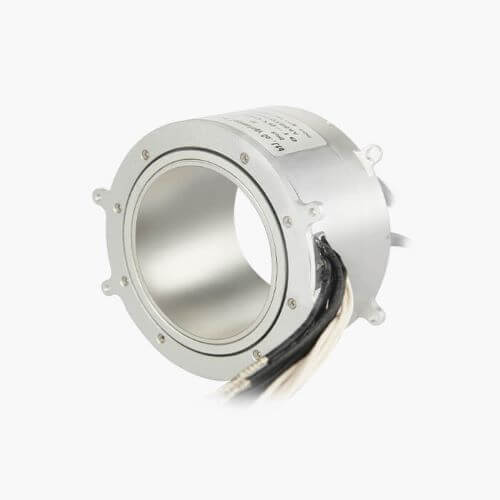
Characterized by their flat, disc-shaped design, these slip rings provide reduced height for use in constrained spaces. They commonly cater to applications in radar systems or stage lighting and can be tailored for power or signal use.

Employing a liquid metal contact – mercury – instead of brushes, these slip rings deliver low contact resistance, minimal noise, and reduced wear. They are used in audio equipment and performance racing vehicles, transmitting power or signals where needed.
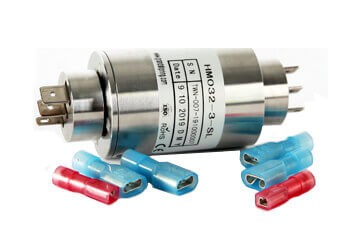
Fiber Optic Rotary Joints (FORJ)
A specialized type designed for optical signal transmission instead of traditional electrical signals. FORJs are used in telecommunications, military, and oil and gas applications that demand high-speed data transmission.
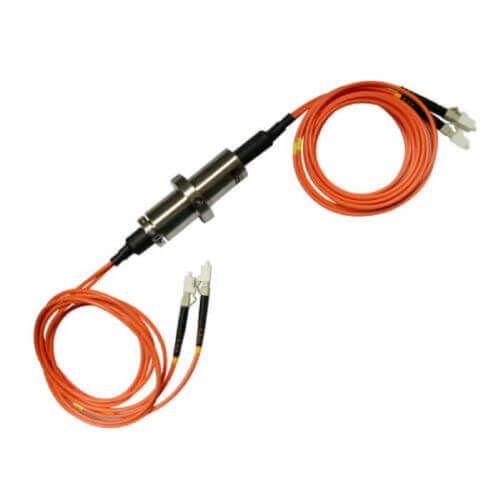
These slip rings cater to systems requiring high-frequency signal transmission, often used in satellite communication systems, radar antennas, or microwave transmission towers.
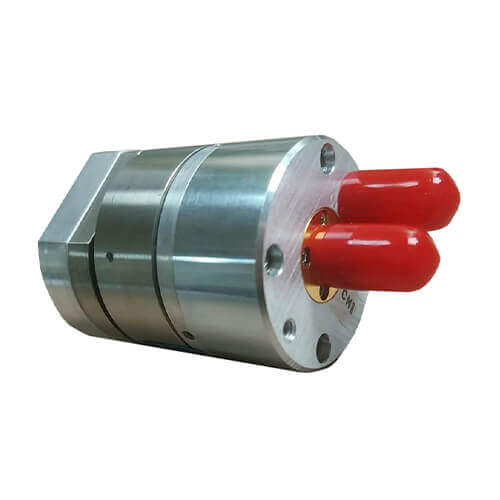
Though the mentioned slip rings differ in design and construction, many can function as either power or signal slip rings depending on their application requirements. Power slip rings prioritize the efficient transmission of electrical power through their conductive elements, allowing the seamless operation of rotating systems requiring power. Conversely, signal slip rings are tailored to ensure minimal signal loss and distortion, affording smooth communication between moving and static components.
Understanding the diverse types of slip rings ultimately highlights the adaptability and versatility of this technology. The unique characteristics of power and signal slip rings enable their efficient integration across an extensive range of industries, further emphasizing their invaluable contribution to modern-day systems and applications.
Power and Signal Slip Rings – Key Features and Advantages
Power and signal slip rings are comprised of a dynamic suite of features, rendering them critical for various applications. These features and subsequent advantages make them a preferred choice over other options available in the market.
- Minimal Electrical Noise: Power and signal slip rings are designed to have minimal electrical interference, offering cleaner and high-quality signal transmission. This feature is mainly vital in applications where high-precision signal handling is required, such as medical imaging devices and satellite communication systems.
- Low Electrical Resistance: To ensure efficient transmission of power, these slip rings are constructed to exhibit low electrical resistance. This feature allows for minimal power loss during transfer, optimizing the performance of devices like wind turbines, rotating tanks, and processing units.
- High Data Transmission Rates: Signal slip rings, especially those with fiber-optic channels provide high-speed data communication, making them useful in emerging high-speed data and video transmitting applications, like surveillance systems and high-end telecommunications.
- Longer Lifespan and Durability: Owing to the use of robust materials in their construction, these slip rings can withstand harsh operating conditions. Lower wear and tear, coupled with the ability to last for millions of rotations, further prolongs their life expectancy and reduces maintenance requirements.
- Compact Design: The compact design of power and signal slip rings allows them to be deployed in applications with space constraints. They provide exceptional functionality without compromising on space, allowing for streamlined system designs.
The advantages of power and signal slip rings extend beyond their technical features. Notably, these slip rings allow for both power and data to be transferred simultaneously over the same device. This multi-channel capability results in reduced costs, lower maintenance complexity, and higher system efficiency compared to using separate devices for power and signal transfer.
Furthermore, advanced slip rings, especially those with sealed construction, can operate effectively even in demanding environmental conditions including high temperature, dust, and moisture. This grants them the ability to be deployed in a broad range of applications, from marine environments to desert-based solar plants.
In comparison to other alternatives, power, and signal slip rings offer greater scalability. With various options in terms of size, type, and capacity, they can be customized to suit specific requirements.
Thus, the unique features of power and signal slip rings, coupled with their advantages, make them a superior choice for continuous power supply and data transfer in rotating machinery across numerous industrial, commercial, and defense applications. The inherent flexibility and versatility of power and signal slip rings will continue to drive their widespread adoption in the years to come.
Applications of Power and Signal Slip Rings
Power and signal slip rings have found their way into a plethora of industrial applications, owing to their fundamental properties of allowing uninterrupted power transmission and smooth signal communication in rotating machinery. The features and benefits associated with these devices make them an ideal choice for many sectors.
- Wind Energy Systems: Power and signal slip rings play a pivotal role in wind turbines. They transmit power from the rotating turbine blades to the stationary generator. Signal slip rings facilitate the communication necessary for monitoring and controlling the turbine operations. The use of slip rings here is largely due to their ability to withstand harsh environmental conditions and the high rotational speeds of wind turbines.
- Medical Equipment: Slip rings are instrumental in medical imaging devices such as CT scanners and MRI scanners. Here, power slip rings deliver the necessary electrical power to the rotating components, while signal slip rings ensure high-quality transmission of the image data without distortion. The use of slip rings in these applications is due to their precise signal handling and space-saving design.
- Military and Defense Systems: Power and signal slip rings are used extensively in radar antenna systems, spacecraft, and tanks. The slip rings are responsible for transmitting power and signals in the rotating parts of these systems for communication, control, and surveillance. The robustness, reliability, and long lifespan of slip rings contribute to their usage in this critical sector.
- Industrial Automation: Robotic arms and automated production lines leverage slip rings for the power necessary to move parts and carry loads. Signal slip rings ensure seamless transmission of control signals and mitigate the issue of tangled wires during the constant motion of machinery. The adoption of slip rings in these applications is due to their compact design and high-performance efficiency.
- Entertainment Industry: Within the world of entertainment, slip rings are used in rotating stages for concerts, theme park rides, and video camera systems. They ensure continuous power for lighting and action, while signal slip rings coordinate the various aspects of the performance or capture high-quality video footage. The continuous, smooth operation capability of slip rings makes them indispensable in these applications.
These applications, while diverse, hinge on one common theme: the need for continuous power and/or signal transfer in systems involving rotational movement. Power and signal slip rings provide a reliable, durable, and efficient solution to the challenges presented by such applications and are therefore chosen as critical components in these systems. Their presence across a wide range of industry sectors underscores their importance and underscores just how integral they are to modern operations and processes.
Power and Signal Slip Rings – User Concerns and Common Issues
Users of power and signal slip rings could potentially encounter a spectrum of concerns related to installation, maintenance, signal interference, and life cycle management. Addressing these worries is essential for optimal operation, and underlines the need for relevant preventive measures.
- Installation Difficulties: The installation process can pose challenges, particularly in a complex system setup. Meticulous planning is required to place the slip ring correctly within the system, ensuring accurate alignment and spacing.
Solution: Detailed installation guides and trained technicians can greatly simplify the process. Additionally, considering slip rings with simpler designs or those designed for easy integration during the system development phase can save time and eliminate potential complications. - Maintenance Issues: Maintenance and potential replacement concerns are common due to the slip ring’s high activity levels. The prime worry is the wear and tear of the contact materials, leading to a decline in performance over time.
Solution: Regular inspection and preventive maintenance are vital to keep the slip ring operating at optimal conditions. Greasing and cleaning regularly, along with periodic performance tests, can prolong the life of the slip ring. Selecting slip rings with robust construction and high-quality contact materials can also mitigate high maintenance concerns. - Signal Interference: This can lead to distortion or loss of data during transmission, which is a significant problem, particularly in signal slip rings. External electromagnetic fields, dust, moisture, and corrosive environments can contribute to this issue.
Solution: Opt for slip rings designed to minimize noise and signal degradation. Protective housings can help slip rings withstand hostile environments. Using slip rings with shielded cables can also curb electromagnetic interference, thereby ensuring signal integrity. - Life Cycle Management: Users are often concerned about the lifespan of their slip rings due to factors like consistent high-speed rotation and exposure to extreme conditions.
Solution: Using high-quality slip rings with advanced materials and engineering that can tolerate extreme rotational speeds and harsh environmental conditions can extend the product’s life cycle. Regular maintenance and performance checks are also key in determining when a slip ring needs to be replaced.
Addressing the common concerns related to the use of power and signal slip rings not only guarantees their efficient performance but also instills confidence among users regarding their reliability. By acknowledging these issues and adopting preventive measures, users can fully leverage the benefits these essential devices offer, ensuring the smooth operation of numerous applications.
Future Trends in Power and Signal Slip Ring Technology
As technological advancements continuously shape the world of electronics, so too does it influence the evolution of power and signal slip rings. Pioneering trends in slip ring technology open the pathway to more efficient, reliable, and high-performing devices, capable of addressing the increasing demands of modern, dynamic applications.
- Increased Use of Fiber Optic Slip Rings: With the rise of high-speed data transfer needs, we can expect to see increased adoption of fiber optic slip rings. Fiber optic technology ensures large bandwidth capacity and high-speed data transmission with minimal signal loss or interference. This advancement will greatly enhance the efficiency and reliability of data communication in various systems, such as surveillance and telecommunication applications.
- Wireless Slip Rings: The concept of wireless power transmission can revolutionize the traditional design of slip rings. By eliminating the need for physical contact, these designs can reduce wear and tear, largely eliminating maintenance issues. The increase in efficiency and decrease in maintenance would make them highly desirable.
- Miniaturization: With the trend of space-saving in systems design, smaller, compact slip rings are expected to be in high demand. Miniature slip rings will be able to deliver the same performance as their larger counterparts while occupying significantly less space, making them ideal for medical equipment, robotics, and other compact systems.
- Material and Design Innovations: Future advancements in contact materials and design techniques could drastically improve the performance, lifespan, and resistance to harsh environmental conditions. This would, in turn, decrease the frequency of maintenance and replacement of slip rings in demanding industrial environments.
- Intelligent Slip Rings: The integration of sensors and smart technology into slip rings could provide real-time performance data and predictive maintenance alerts. This advancement would greatly enhance system control and prevent unexpected breakdowns, thus improving both productivity and maintenance management.
These anticipated advancements in power and signal slip ring technology not only pave the way for improved efficiency and better performance but also promise to alleviate maintenance concerns. Each innovation propels the capability of slip rings to meet advanced application demands, growing in concert with the technological progress that underlines modern society. By capitalizing on these advancements, users can fully harness the potential of slip rings and ensure the smooth, continuous operation of numerous applications.
Conclusion
Acknowledging the fundamental role and cardinal features of power and signal slip rings, alongside confronting user concerns and future outlooks, the resilient progression in slip ring technology gets illuminated. Undoubtedly, power and signal slip rings remain pivotal in maintaining efficient power and data transmission in rotating equipment, persistently driving several industries toward success.
FAQs about Power and Signal Slip Rings
To help users gain a better understanding of these essential devices and address common concerns, here is a compilation of frequently asked questions and their respective answers.
Q1: What is the difference between power and signal slip rings?
A: Power slip rings are designed to transmit electrical power from a stationary source to rotating equipment, such as motors or generators. They can handle higher currents, making them ideal for applications involving high levels of power transmission. Signal slip rings, on the other hand, are engineered to transmit electrical signals, such as data or communication signals, between stationary and rotating sections of a system. They are optimized for minimal signal noise and interference, ensuring high-quality and reliable signal transmission.
Q2: How do I choose the right slip ring for my application?
A: Selecting the ideal slip ring depends on several factors, including the application requirements and the conditions in which the slip ring will operate. Key criteria to consider are the required number of channels, electrical current or signal type to be transmitted, rotational speed, operating temperature, available space, withstanding environmental conditions, and budget. Additionally, consulting with a slip ring expert or manufacturer can help guide you in making an informed choice.
Q3: Can I use one slip ring for both power and signal transmission?
A: Yes, many power and signal slip rings are designed to accommodate both types of transmission within a single device, also known as a hybrid slip ring. These versatile slip rings offer the convenience of transmitting power and signals through the same component, reducing costs, simplifying maintenance, and saving space in the system design.
Q4: How do I ensure the longevity and optimal performance of my slip ring?
A: Proper installation, regular maintenance, and suitable environmental protection are critical in ensuring the longevity and optimal performance of a slip ring. Conduct periodic inspections, cleaning, and greasing to minimize wear and tear. Performance tests will help assess any potential issues that may need to be addressed. Additionally, choosing a slip ring that suits specific application requirements and environmental conditions will further contribute to maximizing its life cycle.
Q5: Are slip rings only used in industrial applications?
A: While slip rings are predominantly employed in industrial applications, their versatility extends to various sectors including medical, military, entertainment, and renewable energy. Their ability to facilitate continuous power and signal transmission in systems with rotational movement makes them invaluable in many diverse applications.
See What We Can Do

